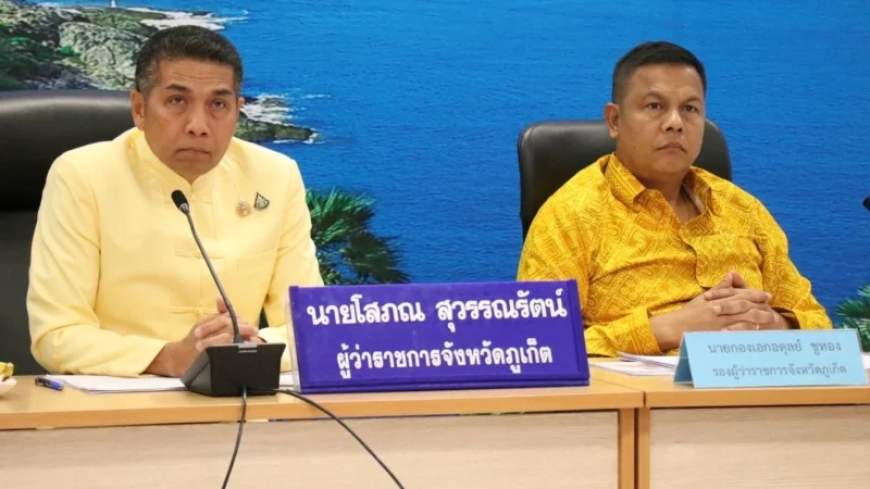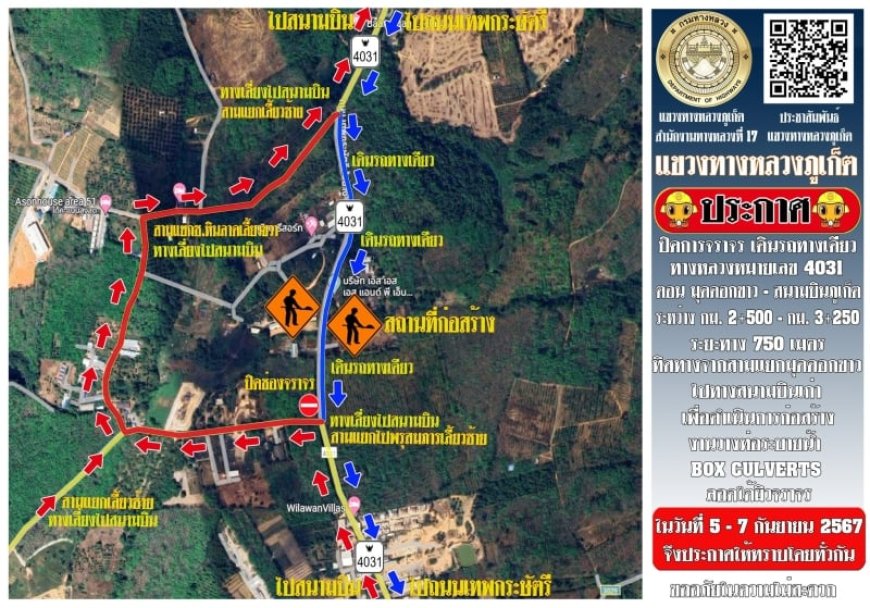Phuket Governor Sophon Suwannarat described the impact of three major flood and landslide disasters that have already hit Phuket this rainy season and issued a series of instructions to authorities to increase vigilance for residents and take measures to prevent further flooding to prevent rain-related disasters.
The governor’s letter was handed over at a meeting at Phuket Provincial Office on Monday (September 2), after which the governor explained his instructions to reporters.
According to an official report of the meeting, Governor Sophon stressed the urgent need to conduct a survey and set up ground movement monitoring stations equipped with equipment to detect and warn of possible landslides and flash floods.
The system is designed to give effective warnings up to one hour before an event and cover all high-risk areas in the province, the report continued.
In addition, plans were discussed to plant banyan trees and giant leucaena as ground cover to stabilise soil. The engineers are also tasked with constructing a water storage weir that can slow the flow of water during the rainy season.
The meeting was attended by Phuket Deputy Governor Adul Chutong, Adviser to the Governor Somkit Chukhong, Phuket Natural Resources and Environment Department Director Wattanapong Suksai and other key officials.
Details of the disaster reported by Governor Sophon are as follows:
Floods on June 30
At around 4 am on June 30, 2024, heavy rainfall of over 330 mm hit Phuket province, causing flooding and waterlogging in several areas in Thalang and Kathu districts.
Affected areas in Thalang district include Pak Klok, Thepkrasatri, Srisongthong, Chenthalay and Sakhusub districts.
In Kathu district, flooding occurred in the townships of Pakkua Law, Baan Pakdee, Baan Nuea and Namtok Kathu (Kathu Waterfall) as well as Kathu and Kamala sub-districts. A landslide was reported at Baan Hua Kuan, Moo 5, Kamala City at 6am.
Floods and landslides affected a total of two districts (Kathu and Thalang), seven sub-districts, 44 villages, four townships, 2,059 households and 6,202 people.
Karon landscape
On August 23, heavy rainfall of 200mm was recorded in several areas of Muang Phuket district. This caused flooding and water accumulation in Chalong, Rawai and Karon. At around 5am, a landslide occurred in Mu 2, Karon Municipality, burying nearby houses.
The disaster affected three sub-districts (Chalong, Rawai and Karon), affecting nine villages, 260 households and 817 people.
The tragedy left 13 people dead and 19 injured. In addition, 170 houses were partially or completely destroyed, and a road called Pakbang Road in front of Karon District was also damaged.
Karon Municipality is currently reviewing the information to ensure its accuracy before submitting it to the Karon Municipality People’s Assistance Committee. The committee was scheduled to meet at its office in Karon Municipality yesterday (September 3) to consider providing assistance in accordance with the Ministry of Health’s internal regulations to discuss the costs of assisting victims under the supervision of local administrative agencies. Location of Ratsada on the globe
Floods and landslides occurred in Thep Buri housing estate, Bang Kuk, Mu 3 District, Ratsada Municipality, on August 28. The disaster affected 50 people from 11 households.
In response, Phuket Province declared Moo 3, Ratsada, a disaster/emergency area due to floods and landslides.
As part of the initial response, Ratsada Municipality set up an emergency evacuation centre at Pim Prapai Place Hotel and provided affected families with temporary accommodation at Ratsada Community School in Naluang District until their homes could be repaired.
As of Monday (September 2), 20 people from five households chose to stay in the emergency evacuation centre. The remaining 30 people are staying with relatives.
Rassada Municipality is providing food and drinking water to the victims in accordance with government regulations.
Measures
According to the official report, Governor Sophon announced that Phuket province has developed guidelines to prevent and manage landslide issues through collaborative efforts of all sectors to ensure public safety.
The province has developed a master plan to manage high-risk areas, accelerated the use of municipal-level landslide hazard maps to inform residents in vulnerable zones, and coordinated with local management organizations to prepare before, during and after natural disasters.
Efforts are being made to develop and implement prevention, monitoring and warning systems using the latest technology, innovations, aerial and satellite images and other relevant data, especially in high-risk areas, the report added. The meeting was presented with a list of 49 “risk areas” for natural disasters.
“These resources are used to maximize benefits in terms of land use, especially public works and building construction,” the report said.
“To warn of landslide and flash flood danger, seismic stations equipped with monitoring equipment have been installed in risk areas, providing up to one hour of warning to residents,” the report added.
The report did not mention that residents of Kalong had complained that a weather monitoring station on the hill where the Kalong landslide occurred had not issued a warning. Authorities later confirmed that the equipment had not been activated. Nevertheless, the official report of the governor’s message on Monday stated that “the Ministry of Mineral Resources has partnered with the National Broadcasting and Telecommunications Commission (NBTC) to monitor and issue disaster warnings for flash floods and landslides through mobile networks to ensure that information is quickly disseminated and efficiently communicated.”
“To further reduce risks to life and property, Phuket Province [Phuket Provincial Administration] plans to plant fast-growing cover crops such as banyan trees and giant leucaena. The Royal Forest Department will coordinate seed procurement, which will be distributed by helicopter to targeted areas,” the report continued.
“Furthermore, the province is working with relevant authorities to design and construct water storage weirs. Engineers are focusing on developing an efficient system that can effectively slow the flow of water during the rainy season,” the report concluded.







